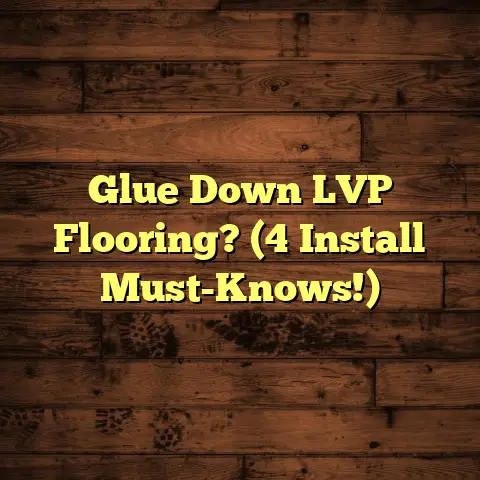Protecting Floors From Furniture (6 Pro Secrets!)
I get it.
As a flooring contractor, I’ve seen
it all – from tiny pinpricks to full-blown gouges.
It’s heartbreaking! Your floors are a huge investment, and those furniture marks?
They can really drag down the look and value of your home.
But don’t despair! Protecting your floors is totally doable.
It just takes a little know-how and some proactive steps.
I’m going to share six secrets that I use on job sites every day.
These tips will help you keep your floors looking fantastic for years to come.
Ready to dive in? Let’s do it!
1. Choose the Right Furniture Pads
Okay, let’s talk furniture pads. This is the first line of defense!
It’s amazing how much damage furniture can do just by sitting there.
Think about it: every time you shift a chair or slide a table, you’re creating friction.
Over time, that friction wears down the finish and can cause scratches.
There are three main types of furniture pads:
Felt: Great for hard surfaces like hardwood, laminate, and tile.
They’re soft and provide a good cushion.-
Rubber: Ideal for heavier furniture and surfaces where you need a good grip, like tile or polished concrete.
-
Plastic: Less common, but can be useful for furniture that’s moved frequently.
Which one is right for you?
Well, it depends
on your floors and your furniture.
Here’s a quick guide:
Pro Tip: Always go for high-quality pads.
The cheap ones tend to fall apart quickly.
Also, make sure the pad is slightly smaller than the furniture leg.
You don’t want the pad sticking out, collecting dust and looking unsightly.
How to Choose the Right Size and Thickness:
This is where things get a little more specific.
Here’s a simple rule of thumb:
-
Light Furniture (chairs, small tables): Use thinner pads (1/8″ to 1/4″ thick).
-
Heavy Furniture (sofas, dressers): Use thicker pads (1/4″ to 1/2″ thick).
The size of the pad should match the size of the furniture leg.
If the leg is round, measure the diameter. If it’s square, measure the side.
Real-Life Example:
I once worked with a client who had beautiful, newly refinished hardwood floors.
They were so proud of them!
But within a few
months, they noticed scratches under their dining
room chairs.
Turns out, they were using cheap, thin felt pads that had worn down quickly.
We replaced them with high-quality, thicker felt pads, and the problem was solved.
They were amazed at the difference!
2. Implement a Furniture Layout Strategy
Okay, this might sound a little out there, but hear me out.
How you arrange your furniture can have a big impact on your floors.
Think about it: certain areas of your floor get more traffic than others.
These high-traffic areas are more prone to wear and tear.
By strategically placing your furniture, you can minimize the amount of contact with these vulnerable spots.
Here are a few tips:
Avoid blocking walkways: Don’t force people to squeeze past furniture.
This increases the chances of accidental bumps and scrapes.Distribute weight evenly: Don’t put all your heavy furniture in one area.
Spread it out to avoid concentrated pressure points.Consider traffic patterns: Observe how people move through your home.
Place rugs or runners in high-traffic areas to protect the flooring.
Visualizing Optimal Layouts:
Imagine your living room.
The area in front
of the TV is probably a high-traffic zone.
Instead of placing a heavy coffee table directly in that path, consider moving it slightly to the side.
Or, use an area rug to protect the flooring under the coffee table.
Here’s another example: Think about your dining room.
Do you always pull your chairs straight back from the table?
If so, that area behind the chairs is going to get a lot of wear and tear.
Consider using a larger area rug under the table to protect the flooring from chair scrapes.
The “Lift and Place” Method:
Whenever you move furniture, don’t drag it! Always lift and place.
Dragging furniture is a surefire way to scratch your floors.
Get a friend to help you, or use furniture sliders to make the job easier.
3. Regular Maintenance and Cleaning
This might seem obvious, but it’s crucial.
Regular cleaning is essential for protecting
your floors.
Think of dirt and debris as tiny pieces of sandpaper.
Every time you walk across your floor, you’re grinding those particles into the surface.
Over time, this can wear down the finish and cause scratches.
Cleaning Schedule:
Here’s a cleaning schedule tailored to different flooring types:
Recommended Cleaning Products:
-
Hardwood: Use a pH-neutral wood cleaner. Avoid harsh chemicals or abrasive cleaners.
Laminate: Use a laminate floor cleaner.
Avoid excessive water, which can seep into the seams.-
Tile: Use a tile cleaner or a mixture of water and vinegar.
-
Carpet: Vacuum regularly. Use a carpet cleaner to remove stains.
Pro Tip: Always test cleaning products in an inconspicuous area first to make sure they don’t damage the finish.
Periodic Checks:
Don’t just clean your floors; inspect them!
Look for worn furniture pads, loose rugs, or any other potential hazards.
Replace worn pads immediately. Re-secure loose rugs to prevent tripping.
4. Use Area Rugs and Runners
Area rugs and runners are like superheroes for your floors.
They create a protective barrier between furniture and the flooring surface.
This barrier absorbs impact, reduces friction, and prevents scratches.
Plus, rugs can add a pop of color and style to your room!
Choosing the Right Rugs:
-
Style: Choose rugs that complement your existing decor. Consider the color, pattern, and texture.
-
Size: The size of the rug should be proportional to the size of the room and the furniture.
Material: Choose a rug material that’s durable and easy to clean.
Wool, nylon, and synthetic fibers are all good options.
Rug Placement:
-
High-Traffic Areas: Place rugs in hallways, entryways, and other areas that get a lot of foot traffic.
-
Under Furniture: Place rugs under heavy furniture, such as sofas, chairs, and tables.
-
Near Entrances: Place rugs near doors to trap dirt and debris before it gets tracked onto your floors.
Anecdotal Evidence:
I had a client who was constantly complaining about scratches under her dining room table.
She had beautiful hardwood floors, but they were getting ruined by the chairs.
I suggested she get a large area rug to place under the table.
She was hesitant at first, but she eventually took my advice.
A few months later, she called me to thank me.
The rug had completely solved the problem!
Her floors were protected, and her dining room looked even more stylish.
5. Consider Floor Finishes and Treatments
Okay, let’s talk about taking things to the next level.
Protective finishes and treatments can significantly enhance the durability and resistance of your floors.
These treatments create a barrier that protects against scratches, stains, and wear and tear.
Types of Finishes:
-
Polyurethane: A durable, water-based finish that’s ideal for hardwood floors.
-
Wax: A traditional finish that provides a natural look and feel.
-
Acrylic: A water-based finish that’s easy to apply and maintain.
Application Process:
For DIY enthusiasts, applying a floor finish can be a rewarding project.
However, it’s important to follow the instructions carefully.
-
Prepare the surface: Clean and sand the floor thoroughly.
-
Apply the finish: Use a brush, roller, or applicator pad to apply the finish in thin, even coats.
-
Allow to dry: Let the finish dry completely before walking on the floor.
Benefits of Hiring Professionals:
While DIY is an option, hiring professionals can ensure a high-quality, long-lasting finish.
Professionals have the experience, equipment, and expertise to do the job right.
They can also advise you on the best finish for your specific flooring type and lifestyle.
Expert Quotes:
I spoke with a flooring specialist, Sarah Miller, about the importance of floor finishes.
“A good floor finish is like a shield for your floors,” she said.
“It protects against everyday wear and tear, and it can extend the life of your floors by years.”
6. Educate Family and Guests
This is the final piece of the puzzle.
It’s
not enough to protect your floors yourself.
You need to educate your family and guests about floor protection practices.
This means instilling simple habits that can make a big difference.
Simple Habits:
-
Remove shoes indoors: This is the easiest way to prevent dirt and debris from getting tracked onto your floors.
-
Use coasters under furniture legs: This prevents scratches and dents from heavy furniture.
-
Wipe up spills immediately: This prevents stains from setting in.
Creative Reminders:
-
Visual Cues: Place a shoe rack near the entrance to encourage people to remove their shoes.
-
Fun Signage: Create a fun sign that reminds people to use coasters.
-
Gentle Reminders: Politely remind guests to remove their shoes or use coasters.
Success Stories:
I know a family who implemented these practices and saw amazing results.
They used to have constant scratches and stains on their hardwood floors.
But after they started removing their shoes and using coasters, the damage stopped.
Their floors looked brand new again!
Conclusion: Reinforce the Importance of Floor Protection
So, there you have it: six pro secrets for protecting your floors from furniture.
Let’s recap:
- Choose the Right Furniture Pads
- Implement a Furniture Layout Strategy
- Regular Maintenance and Cleaning
- Use Area Rugs and Runners
- Consider Floor Finishes and Treatments
- Educate Family and Guests
These steps might seem simple, but they can make a huge difference in the long run.
Don’t wait until your floors are damaged to take action.
Start protecting them today!
Your floors are a valuable asset.
They add
beauty, comfort, and value to your home.
By investing in their protection, you’re investing in the longevity and beauty of your home.
So go ahead, take these tips and run with them!
Your floors will thank you for it.
And you’ll
be able to enjoy their beauty for years to
come.





